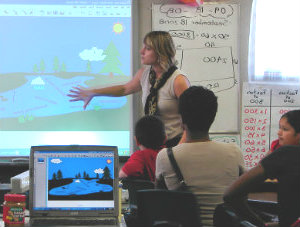Keep the Learning Alive in Co-Taught Classrooms
A MiddleWeb Blog
I want to share a classroom experience that proves students moving into the middle grades can remain enthusiastic readers and writers within an authentic process of learning.
No test. No pressure. Just risk-free, engaging learning.
And the interesting part is—with experiences like these—the test scores will take care of themselves. Students gain the skills they need to succeed during instructional moments and beyond.
Keeping the spark alive
In my last post I shared some thoughts about school trends and how they impact a student’s learning career throughout elementary, middle and high school. For the most part, students start out enthusiastic to learn. They want to learn to read, to write, and to take charge of their education. It’s no surprise that young students exude a genuine enthusiasm and dedication to be active learners.
And then, along the way, some kids lose their zest for learning. Those once curious students become passive listening posts in classrooms where such behavior is tolerated and even welcomed. In too many cases, high stakes testing pressure begins to drive all the liveliness out of school.
This is just wrong. But we know that already. I’m here to talk about possibilities, about effective ways to bring the passion and excitement back.
Who’s who
Before we enter the classroom of Mrs. Rhodes and Mrs. Copeland, let me give you a brief introduction. They are co-teachers in a 4th grade classroom. This is their second year working together, and both are veteran teachers with more than 10 years of teaching experience.

As my district’s Special Education/UDL Instructional Coach, I first met with my pair of colleagues to brainstorm strategies needed to guide students to read complex text. They then invited me to their classroom to provide feedback relating to the ways they are applying the principles of Universal Design for Learning (UDL). I spent some time observing and the rest of the time joining in on the teaching and learning process.
Co-teachers that click / Students that learn
The students were sitting at their desks, which were arranged in a U-shape, all facing the interactive whiteboard. Mrs. Copeland was leading the class discussion about the importance of active reading. She informed the class that today they would add to their personal reading toolbox.

The students were engaged. They were keeping up with the live discussion and natural conversation between the two teachers. They were reading along with their individual copies of the nonfiction article under discussion. They were learning how to deepen their level of reading comprehension.
The best part? They didn’t even realize they were “going deep.” They were just engaged by their 10-minute conversation (or mini-lesson) with their teachers. It wasn’t about “the test.” It was all about interesting stuff.
And the engagement continued! Using the Random Group Generator on the SMART Board, groups were formed. Mrs. Rhodes, Mrs. Copeland, and I worked with students in small groups. We continued the work that began as a whole class. Students were applying the strategy and deepening their comprehension on a more individualized basis. Time flew by—no one moved when they were told it was time for lunch. Some students even offered to stay and read rather than go to the lunchroom. Imagine that!
Evidence of UDL guidelines in this classroom
Multiple Means of Engagement
- Two teachers modeling engagement and natural learning process through authentic conversation
- Cooperative learning groups
- Think-Pair-Share
- Opportunities to self-regulate through strategy use
Multiple Means of Representation
- SMART Board presentation
- Individual copies of nonfiction article
- Auditory/Visual supports
- Additional examples and modeling provided
Mutltiple Means of Action & Expression
- Oral/written expression
- Annotating in margin
- Highlighting or underlining key words
- Whole class listening/speaking opportunities
- Small group cooperative group discussion
Tips for keeping learning alive in inclusive classrooms

- Check in with each other: Ask, “How do you feel things are going? What can you add…” Bottom line—care about how your co-teacher feels and what he or she has to bring to the classroom.
- Enjoy the moments: Stay in the moment so that you can actually enjoy the process of learning yourself!
- Value one another’s expertise:Each teacher should have time to shine and add another layer to the learning process.
- Value student voice: Give students the time to process the information and share their thinking about new knowledge.
- Vary the co-teaching models: In this lesson, Mrs. Rhodes and Mrs. Copeland implemented Team Teaching; One Teach, One Support; and Parallel Teaching.
I won’t make you wonder any longer (I also realize there really isn’t enough evidence in this post!). Mrs. Copeland is the special education teacher extraordinaire. And Mrs. Rhodes is the remarkable general education teacher who just knows instinctively what is right for all learners (including teachers!). They are truly a dynamic duo.
How can we take this kind of energy and love for learning and carry it through the grades—straight through to high school graduation (and beyond!)?
Perhaps the answer is in a quote from Sir Ken Robinson:
If you’re a teacher, you’re the system for your students; if you change what you do, you change the system.





































This was wonderful! I feel it is so important to instill a love of learning. This will not only encourage students to strive to reach new heights, but allow for deeper, richer learning.
Bernadette, I’m so excited to see your comment here! Perhaps our readers will have a question or two for you–thank you for sharing your expertise and inspiring this blog post! And I’m looking forward to coming into your classroom again soon!
You’ve hit the nail on the head all the way! I quit worrying about tests a very long time ago (I’m looking at retirement next year after 42 years in various classrooms). Kids who enjoy reading make progress time after time. And develop skills while doing so! I am currently in what passes in this district for co-teaching. I’m the special educator. Unfortunately I never see the gen. ed. teacher and am expected to pull my students out 100%. What a loss to all of us!
Sue, your comment inspires active focus on what’s most important–our connection with students and an authentic learning process! Your comment also tugs at the heartstrings of all co-teachers who work so hard to collaborate, communicate, respect, and meaningfully educate. 100% pull-out is just wrong. There I said it. So you have me inspired and all fired up at the same time.
In fact, you’ve just sparked the topic of a future chat on Twitter–and perhaps even a not-so-far-off in the future blog post! Would love to chat more with you if you’re interested.
Thanks so much for your thoughtful, relevant, and necessary comment in order to elevate what happens in co-taught classrooms.